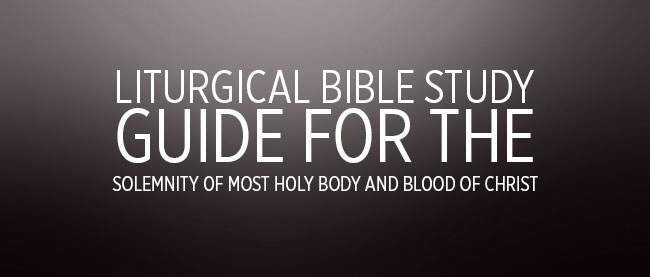Introduction
Corpus Christi is a doctrinal feast established in honor of Christ present in the Eucharist. Its purpose is to instruct the people in the mystery, faith, and devotion surrounding the Eucharist. The celebration of the feast evolved during the 13th and 14th centuries. The Berengarian heresy of the mid-11th century (named after Berengar of Tours) taught that the Eucharist was only the figure of Christ. By the 13th century reception of communion was less emphasized and was to some extent superseded by merely seeing the Host. In 1209 Juliana of Liege had a vision which demanded a feast specifically for the Eucharist. After much persuasion the feast was celebrated for the first time in 1247, and Pope Urban IV extended it to the Universal Church in 1264. Although there is trustworthy evidence that Saint Thomas Aquinas composed two offices for the feast, it is by no means clear that the office now used is from his pen.
1st Reading – Deuteronomy 8:2-3, 14-16a
On the plains of Moab, God charges Moses, now close to death, once more to proclaim the Law which he received through the revelation on Mount Sinai. This proclamation is contained in the 5th and last book of the Pentateuch called in Hebrew had-deb harim (the words) and by the Septuagint deuteronomion (second law). Moses is addressing a new generation of Israelites, all those who would have been under the age of 20 when the exodus began. By having the Law read again, Yahweh is saying that His covenant with Israel is made with all generations (Deuteronomy 29:13), past, present, and future: it is an everlasting covenant. We will read all of Deuteronomy chapter 8 in order to appreciate the context of today’s reading.
2nd Reading – 1 Corinthians 10:16-17
Saint Paul established the Christian community at Corinth during his second missionary journey (A.D. 50-52). He preached the gospel there for a year and a half, aided by Silas and Timothy. After he left Corinth, the city had a series of apostolic visitors. Apollos, a brilliant preacher (Acts 18:24-26) arrived about a year after Paul left. It is likely that around this time Peter also paid a short visit to Corinth, although it is not recorded. This letter was written shortly before Easter 57 and offers the Corinthians guidance on some areas that they have found problematic. One of the problems which Paul addresses is the significance of social gestures. The idea of unity and fellowship with God through eating a sacrifice was strong in Judaism and Christianity as well as in paganism. In Old Testament days, when a Jew offered a sacrifice, he ate a part of that sacrifice as a way of restoring his unity with God, against whom he had sinned (Deuteronomy 12:17-18). By participating in temple banquets (there were temples dedicated to the cult of the emperor, to various Greek deities, and to Egyptian gods in Corinth), Christians had no intention of worshiping idols, but Paul believed that such social gestures had an objective significance independent of the intentions of those who made them; they gave the appearance of acceptance and worship, even when it was not intended. He makes his point by using the Eucharist as an example of a banquet of unity. Catholic Christians participate in Christ’s once-for-all sacrifice when they eat and drink the Body and Blood of Our Lord in Holy Communion.
Gospel – John 6:51-58
The time is about one year before Jesus’ death and resurrection. There are three Passover periods mentioned in Holy Scripture; all of which appear in the Gospel of John:
Jn 2:13-23 – The cleansing of the temple immediately after the marriage feast at Cana.
Jn 6:4 – The feeding of the 5,000 which, along with Jesus’ walking on water, immediately precede this bread of life discourse.
Jn 11:55 – Jesus’ passion and death
The Gospels of Matthew and Mark also include miraculous healings, the casting out of demons, and the feeding of the 4,000 prior to this event.


